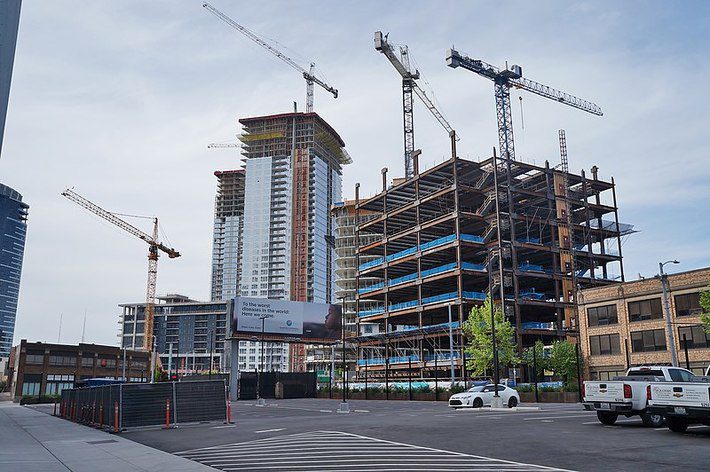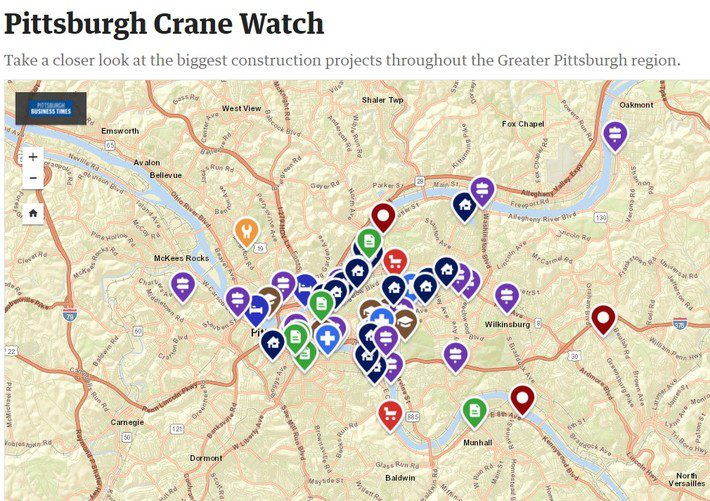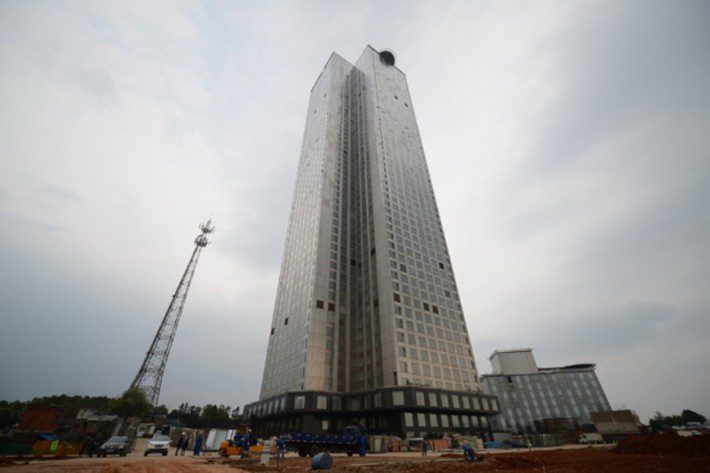
High-rise construction in the Denny Triangle area of Seattle. Source: Bruce Englehardt, Wikimedia Commons, May 2020
I’ve been looking for fresh use cases that tell the knowledge graph adoption story from new angles. Which industries, for instance, been having success recently that we didn’t know about before?
It was surprising on the last day of 2021 during a demo from Co-Founders Frederick Gibson and Kai Gilb of Graphmetrix to discover what’s been happening in the construction industry on the knowledge graph front in recent years and why.
First, I’ll give a bit of background on commercial construction and some recent trends, and then we’ll follow up on how semantic graphs are poised to solve some of the most nagging knowledge sharing problems the industry has.
High rise growth in urban centers
Here in the US, as in Europe and some other places around the world, you’ll see many tower cranes in the downtowns of cities. Each of these cranes can lift as many as 20 tons of steel girders and other construction materials. They’re essential for high-rise building.
Despite numerous delays due to the pandemic, developers in the City of London plan 587 high rises over the next decade, according to the Daily Mail.
Here in the Bay Area, we’ve had a number of cranes working in places like San Jose. Last I checked, 44 buildings above nine stories high were proposed in this town that calls itself “the Capital of Silicon Valley.” 20 or more of these will likely be approved and built.
Austin, Seattle and Chicago are among the cities noted recently who’ve had the same tower crane thing going, with a number of cranes downtown right next to high-rise sites, each looking like another Dippy Bird ready to take another sip out of a water glass.
Nashville may have even more tower cranes than the others I’ve mentioned – reporters counted as many as 36 cranes deployed a couple of years ago, and this past March, local news station WKRN reported that nearly $4.7 billion in construction value had been permitted over the course of 2020.
Name your US tech hub or NFL city, and you could guess there will be multiple tower cranes working in each one. Of course Vegas, new home of the Raiders, has construction underway for several high rise hotels with more than 30 stories each. Various different local editions of the Business Times in the US maintain Crane Watches–Google Maps with new and proposed construction details plotted. In Pittsburgh’s case, there are over two dozen projects underway along the Allegheny and Ohio, near where the two rivers intersect.

Pittsburgh Business Times, Dec. 2021
High rise innovation
136 years after the Home Insurance Building, the world’s first modern skyscraper, was built in Chicago, you’d think high-rise construction would be highly efficient by now. And it is, in many ways. China’s Broad Group, using Lego-like prefabrication methods such as prebuilt, prewired and pre-plumbed floors and columns, erected a 57-story high rise called Mini Sky City in Changsha, the capital of Hunan Province, in 19 days in 2015. Broad Group now claims dozens of finished high-rise projects using extensive prefabrication methods.

China Daily and Broad Sustainable Building, May 2015
Besides prefab becoming more and more common, whether commercial or residential, social media is full of videos touting everything from advanced robotics systems laying bricks to 3D printed building methods for Habitat for Humanity housing. When it comes to complex projects and reducing layers of inefficiencies, the issue isn’t construction technology; it’s information technology that’s the stumbling block.
Construction knowledge sharing and version control innovation
Architects have confronted change distribution problems for many years. On the one hand, it’s quick and straightforward for them to update a drawing. But on the other, how do they make sure the general and all subcontractors are working from the same drawing with all the same changes incorporated?
Part of this is a version control problem, one that CEO Frederick Gibson has been working on since he led Bechtel’s Semantically Linked Knowledge Platform project from 2014 to 2018. Key to Graphmetrix’s approach is to innovate using the same formats the construction industry uses for information sharing. PDF, for example, is one of the main document format targets for Graphmetrix’s knowledge sharing innovation, just because the construction industry is so deeply in the habit of using PDFs to share drawings.
But the real power of the platform is the meaningful linkages that become possible across building projects and even across entire supply chains. Graphmetrix has aggregated 100 different ontologies to represent and articulate the model of an online “world”, according to Gibson. That graph data model knits together the “world” in data as digital twins and makes it possible to search for “units of thought” within the context of those twins via the knowledge hypergraph instead of mere keywords. And the system can extract a knowledge hierarchy from each individual page.
From the vantage point of a builder on a project viewing a PDF, Graphmetrix makes sure the knowledge network imbues each document with the latest changes and highlights those changes with color-coding when viewed on a smartphone or other mobile device. And the PDFs have other graph-enabled navigation functionality on each page.
Therefore, the platform, in essence, becomes a knowledge network map that users can navigate across, as well as a version-controlled environment that manages, updates, and enables and controls access to all the project or supply chain document files being shared, not only via a knowledge hypergraph but within the boundary-crossing, user data sovereignty preserving application framework of SOLID, a decentralized linked data specification.
The overall platform makes it possible for various contractors and other partners in the supply chain to plug in, connect, share and manage their own views and resources with a unified user experience that grounds each user in
What’s most significant about the Graphmetrix approach to this sort of solution is that they haven’t reinvented the wheel when it comes to any component they’ve made use of–instead, they’ve purposed what’s already been developed in the larger context of a next-generation knowledge linking and sharing platform, one that initially targets the needs of a particular community Gibson as a former architect is intimately familiar with. But later on, the platform could be used by any industry vertical or community with a similar need.
